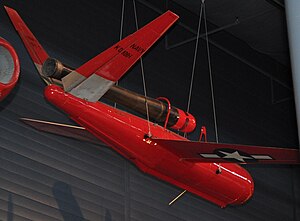|
McDonnell TD2D Katydid
The McDonnell TD2D Katydid is a pulsejet-powered American target drone produced by McDonnell Aircraft that entered service with the United States Navy in 1942, and continued in use until the late 1940s. HistoryIn March 1941,[1] the U. S. Navy awarded McDonnell Aircraft a contract for a radio-controlled target drone under the designation of XTD2D-1 for anti-aircraft and aerial gunnery practice. The aircraft had a mid-mounted wing, V-tail, and McDonnell XPJ40-MD-2 pulsejet engine mounted atop the rear fuselage. The drone could be either launched by catapult from the ground or from underwing racks on Consolidated PBY Catalina flying boats.[2][3] It was gyro-stabilized, and control was by radio command;[4] at the end of its mission the drone could be recovered by parachute.[2] Operational historyThe Katydid entered service in 1942;[5] testing took place at the Naval Air Missile Test Center in Point Mugu, California.[6] Production models were originally designated TD2D-1, however the Navy changed its designation system in 1946 and the XTD2D-1 and TD2D-1 were redesignated as XKDD-1 and KDD-1, respectively. Later that year, the Navy changed McDonnell's manufacturer code letter from "D" - which had been shared with Douglas Aircraft - to "H", the KDD-1 being again redesignated, as KDH-1.[7] Surviving aircraftA KDH-1 is displayed in the Steven F. Udvar-Hazy Center of the National Air and Space Museum, having been donated by the U.S. Navy in 1966.[2] Specifications (KDD-1)Data from Udvar-Hazy Center,[2] Parsch 2003[7] General characteristics
Performance
See alsoAircraft of comparable role, configuration, and era Related lists ReferencesWikimedia Commons has media related to McDonnell TD2D Katydid.
|
||||||||||||||||
